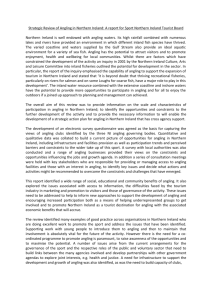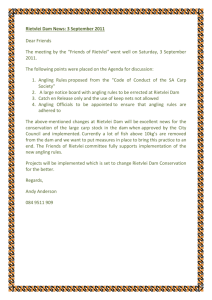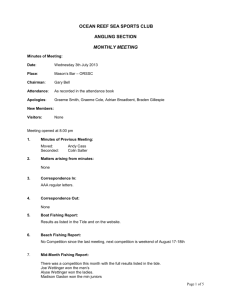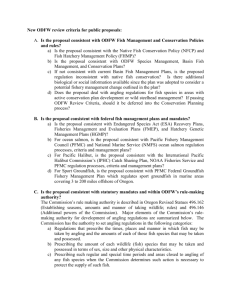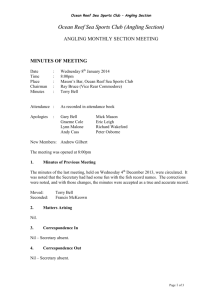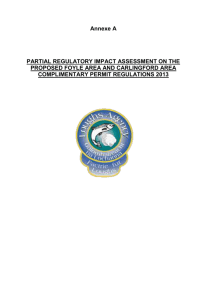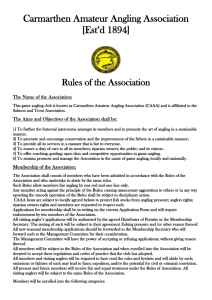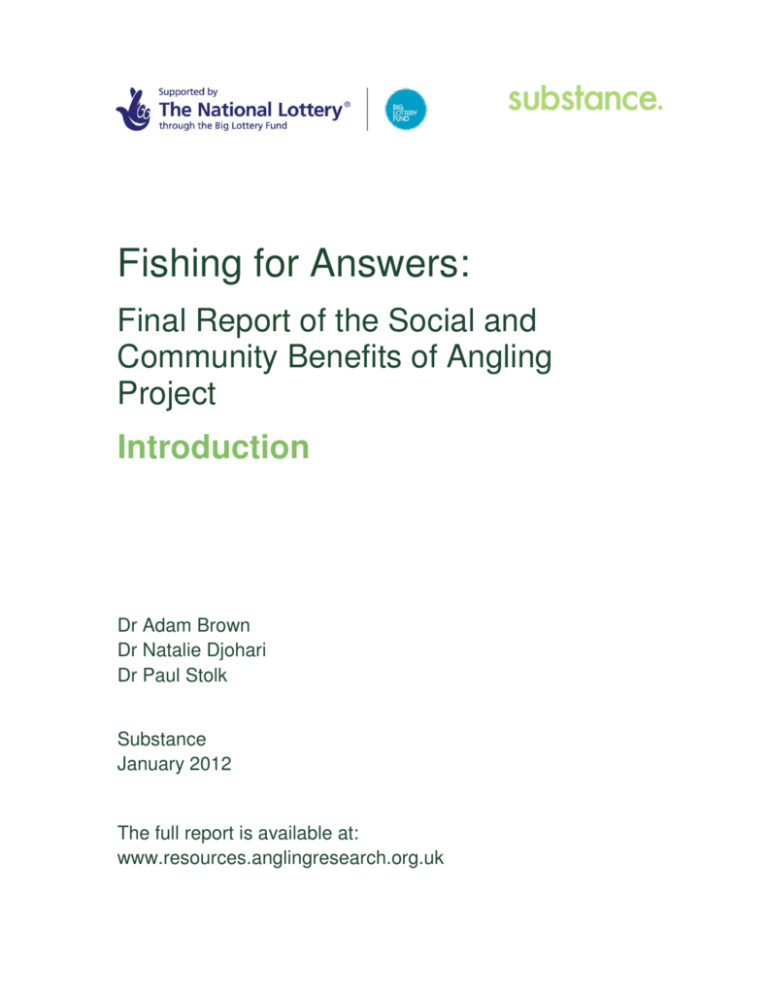
Fishing for Answers:
Final Report of the Social and
Community Benefits of Angling
Project
Introduction
Dr Adam Brown
Dr Natalie Djohari
Dr Paul Stolk
Substance
January 2012
The full report is available at:
www.resources.anglingresearch.org.uk
Fishing For Answers
The Final Report of the
Social and Community
Benefits of Angling Project
Dr. Adam Brown
Dr. Natalie Djohari
Dr. Paul Stolk
Substance
January 2012
Authored by Adam Brown, Natalie Djohari and Paul Stolk
Published by:
Substance
3rd Floor Fourways House
Hilton St
Manchester M1 2EJ
www.substance.coop
All rights reserved.
Designed by Because Studio – www.becausestudio.co.uk
ISBN number: 978-1-906455-02-6
3
Contents
Foreword
4
Acknowledgements
5
Executive Summary 6
Introduction
9
1. Angling and Sports Participation
13
2. Angling and Health and Well-Being
28
3. Angling and the Natural Environment
40
4. Angling and Community Development
51
5. Angling Tourism and Rural Communities
63
6. Angling and Young People
77
Concluding Comments
91
4
Foreword
The Relevance
of a ‘Hidden’ Activity
Angling is in many ways a ‘hidden’ activity.
It is not something that commands great media attention (and income) like football, cricket or rugby even though it has as
many if not more participants. It is not often a part of the everyday ‘vista of life’, like seeing people cycling or running, although
it goes on all around us. Angling doesn’t generate much mainstream media hype around its celebrities, even though it has
them.
Angling isn’t visible in the way other activities are and for most people anglers are people they may see in odd locations
and on odd occasions – by the canal in the city centre or on the beach when on holiday, or in quirky adverts. Such a lack of
encounters generates a more general public ignorance of the activity: the widespread belief that it is entirely sedentary, and
probably involves sitting still, in the rain, under an umbrella, doing and catching little.
Even though it encompasses every shade of enthusiasm, from the person who stumbles onto a boat to catch some mackerel
once in a blue moon on holiday to the angler who dedicates their life to fishing – for many of those who have never taken part,
it remains a mystery. Indeed, the EA reported in 2004 that for over half the people surveyed who had never fished, doing so
simply had not occurred to them.
Whilst you can probably say this about many other sports, hobbies and leisure activities, it is unusual to be able to say so
of an activity that has over 4 million participants in the UK, worth in the region of £3bn to the economy, is so historically
rooted in the nation’s cultural practices, and involves such a diverse range of practices that impacts on the quality of life and
environment of both anglers and non anglers alike.
Our research suggests that the act of fishing embraces everything from sitting with a rod in hand by an urban pond a lone
carp, to climbing mountain peaks in pursuit of hill loch trout, to braving Britain’s coast chasing sea bass. This breadth in the
act of fishing, however, generates a much wider range of other actions with real social, environmental and economic impacts.
So our research also suggests that angling is about volunteering – to run clubs and associations. It is about business and
consumption - of the myriad magazines, websites and forums, tackle providers, TV programmes and DVDs. It is about working
to clean up the environment - along rivers and beaches, improving habitats so that biodiversity (including fish) can thrive.
Angling gets people involved in teaching and coaching - where young people learn not just about going fishing but also the
life cycles and habitats of species. It is about the engagement of excluded young people - leading to their ongoing personal
and social development. It involves travel and tourism - helping to sustain rural areas. And it involves family, friendships, social
interaction and debate. Lots of debate.
The title of this report, Fishing for Answers is deliberately aimed to provoke questions amongst a non-angling audience, and to
cause anglers to reflect on how they can successfully communicate the wider benefits of their sport to a non-angling public.
We cannot hope to include everything that this extensive project has encompassed in one report (and we have made all data
and interim reports available in response to this). But we do hope that this final report provides some substance about the
ways in which angling can deliver personal, social and community benefits – and how these can be improved, extended and
developed into the future.
Dr Adam Brown
Research Director of Substance
Angling Project Manager
5
Acknowledgements
This project would not have been possible without the contribution and participation of a huge number of people.
In particular we would like to thank the project’s Advisory Group who have spared invaluable time to support, comment
on, discuss and assist with the research project throughout the three years.
•R
ichard Wightman, National Angling Participation and Development Manager, Environment Agency
•M
ark Lloyd, Chief Executive Angling Trust
• J ackie Sheldon, Senior Development Manager, Angling Development Board
• J onathan Duncan, General Manager Get Hooked on Fishing
•D
r. Elisabeth Oughton, Principal Research Associate, Centre for Rural Economy, School of Agriculture, Food and Rural
Development, Newcastle University
•D
r. Paul Gaskell, Trout in the Town Project, Wild Trout Trust
•E
ric Dawes, Business Development Manager, Angling Development Board of Scotland
•N
aidre Werner, Director, Angling Trades Association
•M
arion Lowe, former Chief Executive Get Hooked on Fishing (to December 2010)
• Ian Robertson, Scottish Country Sports Tourism Group, Scotland (2009)
Angling’s national organisations have given huge encouragement and assistance – the Angling Trust, Angling Development
Board, Angling Development Board of Scotland, Angling Trades Association, Scottish National Angling Association, Scottish
Sea Anglers Federation, Scottish Coarse Anglers Federation and others.
We would also like to thank those projects with whom we have worked most closely during the life of the project. These
include: all the projects trustees and managers of Get Hooked on Fishing; a wide range of other youth projects around the
country; the coordinators of all of the Trout in the Town projects; a number of Assynt organisations (Angling Club, Angling
Association, Crofter’s Trust, Foundation, Community Council); Visit Scotland; the Highland Council; Country Sports Tourism
Group and many more.
Finally we would like to extend our thanks to thousands of anglers, coaches, teachers, parents, young people and others who
have openly shared their experiences and views with us and without whom the research would not have been possible.
About Substance
Substance is a social research co-operative working in sport, youth and community development and beyond. Substance
helps projects and organisations delivering personal, community and social development to improve and demonstrate impact
and value.
This project has been undertaken by Adam Brown, Natalie Djohari and Paul Stolk but has also had invaluable input from David
Carpenter (websites) and associates Eva Serencisova (Assynt interviews), Loz Ives (Because Studio design), Fiona Mcgee
(proofing).
For more information see:
Project Websites:
www.resources.anglingresearch.org.uk
www.anglingresearch.org.uk
www.assynt.anglingresearch.org.uk
www.substance.coop
6
Executive Summary
Introduction
This report is the culmination of three years research into the social and community benefits of angling. The research was
funded by the Big Lottery Fund research programme from 2009-2011 and was undertaken by Substance, a research cooperative based in Manchester, UK.
The project has sought to provide in depth evidence about the different ways in which recreational angling can have positive
benefits for individuals and communities, particularly the people who take part in it and the communities in which it takes
place.
The Final Report is divided into six main sections which seek to summarise findings in areas that are the most important and
most relevant to current policy and practice developments. It is designed to inform and influence future developments in those
areas.
1. Sports Participation
The first section of this report describes angling’s contribution to sport participation outcomes. This incorporates: angling’s
role in encouraging very large numbers of people to participate in a sport incorporating a breadth of physical activity; and how
angling offers a distinctive alternative to other sports, including ‘life-long’ participation, green exercise and distinctive forms of
competition.
It evidences how angling:
•G
ets millions of people involved in sport in the UK
•P
rovides opportunities for many different levels of physical activity for people of all abilities, including the less able
•P
rovides a national infrastructure of clubs and governing bodies
• Is a gateway for a wide range of positive social and environmental activities
•P
rovides opportunities for structured contests as well as distinctive informal competition
•D
iffers as a competitive sport in a number of respects, particularly in enabling accessible, integrated competition
•H
as some barriers to participation that still need to be overcome.
2. Health and Well-Being
Section 2 of the report describes the positive role that angling plays in improving public health and well-being. Angling offers
specific health and well-being benefits: as an informal recreational activity that can build resilience against ill health through
opportunities for relaxation, relief from stress, improved physical activity and access to natural environments; and as part of
targeted intervention programmes that assist in the restoration and recovery from physical and mental ill health.
It evidences how angling:
•C
ontributes to preventative and restorative measures by increasing physical activity and providing programmes that assist
in recovery from physical illness
•M
akes both a preventative and restorative contribution to mental health
• Introduces protective factors that promote good mental health
•P
rovides programmes that assist in the treatment and recovery from mental illness
•H
elps build young people’s relationships and confidence
•P
rovides opportunities for ‘active ageing’.
7
3. The Natural Environment
Angling delivers benefits for the environment and for people accessing natural environments in two principal ways: by
delivering environmental benefits through angler engagement in conservation, ecosystem monitoring and raising environmental
awareness; and by acting as a ‘gateway’ for people to access green spaces and create connections with nature which
improves the well-being of people and their communities.
This section evidences how:
•A
ngling helps improve aquatic habitats
•A
ngling organisations assist habitat conservation that has wider community benefits
•A
nglers can be the eyes and ears of the natural environment because they spend so much time in and around
aquatic habitats
•A
ngling contributes to public knowledge about freshwater and marine environments, both formally and informally.
•A
ngling is a gateway activity for people to make connections with nature.
4. Community Development
This section describes the positive role that angling and anglers can play in local communities in relation to: empowering
people to be active citizens through the development of new or renovated water based community assets; and creating
opportunities for greater cohesion and integration within communities.
It evidences how angling:
•C
an be a means to empower people to become active citizens and bring people from different backgrounds together
•O
rganisations have been instrumental in developing, improving and maintaining community water assets that are accessible
to a range of people from different backgrounds
•C
an build positive partnerships with local authorities and deliver local services that help local authorities and agencies meet
their community obligations
•C
an assist in sustaining integrated and cohesive communities and embrace wider community needs and involve local people
5. Rural Communities and Angling Tourism
This section details the impact of angling in rural and remote communities. It illustrates: the valuable contribution that
angling tourism can make to rural communities in terms of economic impact and wider tourism development; and how the
development of good practice means angling can contribute to sustainable rural community development through employment
and the conversation of cultural heritage.
It evidences how:
•A
ngling tourism can be extremely important in terms of the economic contribution that visiting anglers make to rural areas
•A
ngling tourism can:
•L
engthen the tourist season
•O
ffset declines in other forms of tourism
•C
ontribute to ‘portfolio employment’
•A
ssist in sustaining the cultural heritage of rural communities
•A
ngling tourism can be developed through: provision and presentation of information using state of the art technology;
increased public access to angling; development of a broader outdoor tourism portfolio; the clustering of businesses and
co-operative competition; and community land ownership
•A
ngling tourism needs to be developed sustainably, maintaining a balance between ‘development’ and environmental and
social management factors.
8
6. Angling and Socially Young People
The last section of the report describes the positive role that angling can play in education, personal development and social
inclusion of young people. Compared to other positive activities, angling has a very distinctive offer to make in terms of:
providing personal and social development opportunities; raising attainment in education and employment; and diverting
young people from crime and antisocial behaviour.
It evidences how:
•T
he UK is a leader in the field of delivering personal and social development outcomes for young people through angling
•A
ngling has some distinctive attributes that make it a particularly useful tool for young people’s personal and social
development
•T
he best angling programmes take a holistic approach to tackling young people’s exclusion
•T
he most effective angling diversionary programmes establish exit routes into clubs and wider angling opportunities
•A
ngling programmes are particularly effective at addressing the need for young people to attain in education and training
•A
ngling is particularly suited to helping young people with additional welfare needs and behavioural or learning difficulties,
especially ADHD.
Conclusions and Recommendations
The final section of the report provides a series of recommendations for how the social and community benefits of angling can
be further developed in these six areas. A key aspect of this is a need for the ongoing generation of robust evidence about
angling’s social benefits, beyond the life of this project.
9
Introduction
The Social and Community Benefits of Angling Project Final Report
This report is the culmination of three years research into the social and community benefits of angling. The research
was funded by the Big Lottery Fund research programme from 2009-2011 and was undertaken by Substance, a research
co-operative based in Manchester, UK.
The project has sought to provide in depth evidence about the different ways in which recreational angling can have positive
benefits for individuals and communities, particularly the people who take part in it and the communities in which angling
takes place.
i) The Project Focus
The project has had three principal research areas:
Angling Participation: To understand more about what constitutes angling participation and how that participation can lead
to personal or wider community benefits.
Young People: To explore how angling can be used for positive youth development, particularly amongst those who are
socially excluded or who face additional life challenges.
Rural Communities: To research the role that angling can play in rural areas and in particular the ways in which angling
tourism can contribute to community development.
The project was based on research in England and Scotland specifically, and it is on those two countries that this report
is focused. However, we also considered examples of good practice occurring elsewhere, and the learning is applicable
across the UK.
ii) The Purpose of Big Lottery Funding
The Big Lottery Fund (BLF) research programme sought to enable third sector organisations to undertake and disseminate
evidence based knowledge:
‘to influence local and national policy and practice and, in the longer term, develop better services and interventions for
beneficiaries.’
Angling is on one level a very simple activity – the act of catching a fish with a rod and line. However, it is also complex,
multi-faceted, and a deeply historically rooted part of our culture. Its social effects are multiple and varied and not widely
understood.
Furthermore, over the last decade, there has been an increasing interest in angling practice and policy about how angling
can contribute to wider social and community development outcomes: from the allocation of public resources to increase
and develop participation, to specific programmes that have sought to use angling in instrumental ways for individual and
community development.
Our research has generated an enormous amount of evidence based knowledge about angling and has sought to help inform
and influence those policy and practice developments.
10
iii) The Policy and Practice Context
The research has been particularly timely.
On a national level the first decade of the 21st Century saw moves in both England and Wales and in Scotland to unify the
organisation and governance of angling. This included the formation of the Angling Development Board and Angling Trust in
England (who are due to merge in 2012); and the formation of the Angling Development Board of Scotland. This has been
followed by new funding streams to angling, from sports councils as well as environmental agencies.
On a local level, the last decade has seen an explosion of projects, initiatives, agencies, charities and facilities that have
sought to develop angling participation and use it for the purposes of social, economic and environmental benefit. These range
from projects to help clean up our rivers, to charities helping socially excluded young people, and tourism initiatives.
The changing policy landscape has seen a growing interest at governmental level in how activities in sport, culture and leisure
can deliver social benefits. Alongside this, agendas around health and well-being, environmental improvement, localism and
active citizenship, rural development and youth inclusion have all emphasised the importance of positive activities in delivering
wider social benefit.
Angling-related organisations have begun to articulate how angling can contribute to these agendas and have sought new
evidence to help them ‘make their case’; often finding however, that the evidence was not there. It is within this context that
the Social and Community Benefits of Angling project has taken place.
iv) The Research Context
The BLF research programme supports work that addresses particular evidence gaps. Despite the enormous volume of
angling literature, academically rigorous research into the social aspects of recreational angling in the UK has lagged behind
that of other sports and leisure activities. Whilst there is a developing body of research that has sought to understand the
behaviour of anglers - often referred to as the ‘human dimensions’ of fisheries science research - this has usually been
concerned with the impact of angling on fish and fisheries, rather than the impact of angling on people and communities. It is
with the latter that this project has been focused.
In the UK the relative absence of social science research about angling’s social impact stands in contrast to the significant
bodies of work, for instance in the sociology of sport and leisure studies, about comparable participation activities, including
‘mainstream’ sports and those with high media profiles like football, cricket and athletics. As such there has for some time
been an identified evidence gap in angling research.
In the last decade, interest in research into the social impacts of recreational angling has grown – including a number of
studies about the economic value of recreational angling; a series of reports commissioned and published by the Environment
Agency about participation and public attitudes to angling; and a handful of academic studies.
However, for the most part (and with some notable exceptions) this existing body of work has produced knowledge about
angling’s importance in general terms and on a national scale. Our research, in contrast, has sought to investigate how angling
affects people’s lives, the development of organisations, and particular local communities through a more in-depth focus.
11
Angling is the act of fishing with a rod, line, hook and bait or lure for recreational purposes (as opposed to
subsistence).
There are traditionally three ‘disciplines’ in the UK that are normally recognised within recreational angling and to
which we refer to in this report. They have been the basis around which national organisations have emerged and at
their most basic level describe the kind of fish being caught:
• Coarse fishing – angling predominantly for freshwater fish that you do not usually eat.
• Game fishing – angling that is predominantly for trout, salmon, sea trout and grayling.
• Sea fishing – catching fish that live in the sea.
However, such blunt distinctions mask a myriad of complexities in terms of method, practice, location, species,
cultural tradition and innovation. The terminology of both ‘coarse’ and ‘game’ fish hides some historically rooted
assumptions (and prejudices) as well as changing angling practices. Furthermore contemporary angling practices
suggest a blurring of boundaries that make such distinctions problematic – such as the growth in salt water fly fishing
by many game anglers. Also, the exponential growth in carp angling has seen it emerge as a distinct form of coarse
angling in its own right.
Millions of people take part in angling in the UK. Indeed it is often referred to as the most popular participation sport
or leisure activity in the country. However, this participation involves a diverse range of commitment, involvement,
frequency and practices. As such the definition of what makes ‘an angler’ can be varied and highly subjective.
v) Our Approach
To deliver such a wide ranging multi-faceted project across three years, our approach has necessarily used mixed
methodology. It has involved:
a) Large scale (national) survey work on angling participation involving over 2,400 anglers
b) More focused surveys, including those with over 200 young people, 54 youth projects and over 200 angling tourists
c) Nearly 700 in-depth semi-structured interviews and ‘light touch’ consultations with anglers, practitioners, policymakers and
community members
d) In-depth case study research with angling organisations amounting to over 185 fieldwork visits, over 430 hours of on-site
observation of youth intervention programmes, and action research with youth angling charity Get Hooked on Fishing
e) Case study research in the remote area of Assynt in of Sutherland, North West Scotland. This included repeat fieldwork
visits, consultation with 20 local organisations, surveys of over 300 anglers and visitors, and over 50 in depth angler
interviews
f) Development of bespoke on-line tools, including those for qualitative data submission and interactive digital mapping
amounting to over 280 individual online comment submissions and over 8,000 users of the Assynt Angling Research
website
g) Analysis of particular angling initiatives and events, including National Fishing Month and the Trout in the Town programme
h) Consultation with over 245 angling organisations.
vi) Our Outputs
Summarising such an extensive and complex research project into one report is an impossible task.
Recognising this, as well as the need to use evidence based knowledge to influence policy and practice as the project
progressed, we have sought to publish research throughout the project.
During the three years we published 17 Interim Reports on different aspects of angling and community benefit; 7 papers
for partner organisations that have been the focus of our research; three academic journal articles have been submitted for
peer review publications; 8 conference papers have been delivered; over 20 presentations have been made; and dozens of
meetings have been held with stakeholder groups.
Introduction
In Focus: What is Angling?
12
We also created and launched a bespoke Angling Research Resources website – www.resources.anglingresearch.org.uk
– which provides free, public access to:
•A
ll Interim Reports
•D
ata visualisation, maps charts and graphs
• Interactive data dashboard
•R
aw qualitative and quantitative data files
•S
earchable directories of projects and research sites
•A
unique, searchable on-line library of angling research.
vii) The Final Report
The Final report is divided into six main sections which seek to summarise findings in areas that are the most important
and most relevant to current policy and practice developments. It is designed to inform and influence future developments in
those areas.
These six sections of the Final Report are:
1. Sports Participation: How angling participation meets sports development outcomes, but also the ways in which angling
offers a distinction to other, more high profile, sports.
2. Health and Well-Being: How angling delivers physical and mental health benefits and the unique features of the activity
that lend itself to these outcomes.
3. The Natural Environment: Ways in which angling can lead to environmental improvement, protection and monitoring as
well as enable people to access ‘green spaces’.
4. Community Development: Evidence about the ways in which angling organisations contribute to community asset
development, active citizenship and community cohesion.
5. Rural Areas and Tourism: The contribution of angling tourism to social and economic development of rural communities
and how this can be encouraged further.
6. Excluded Young People: The instrumental use of angling as a tool for the engagement and personal development of
young people, particularly those who are socially excluded or disadvantaged.
The final section provides a summary of recommendations.

